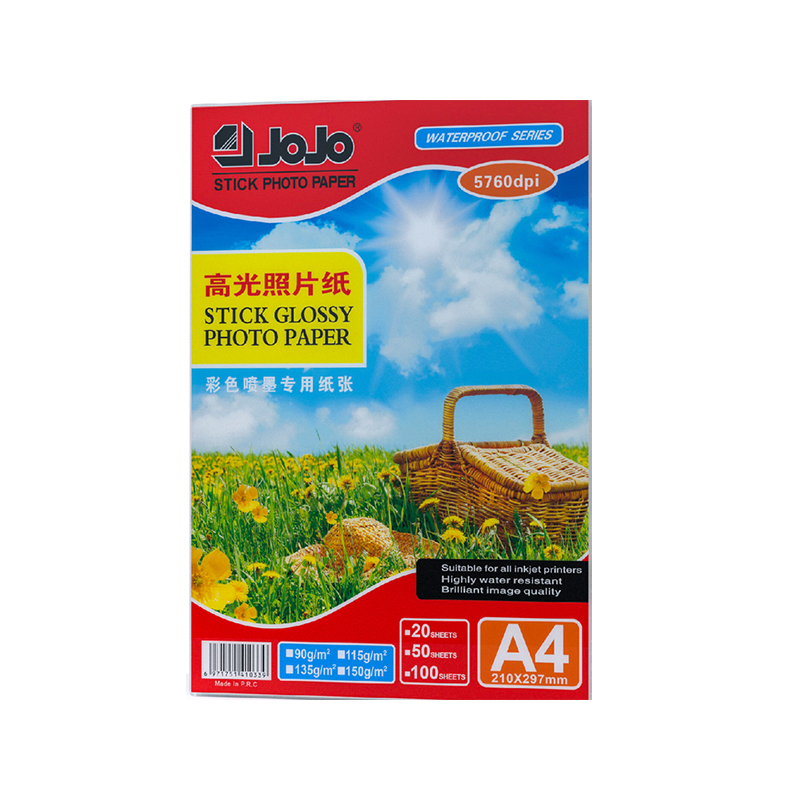If you need any help, please feel free to contact us
What does the grammage of printing photo paper mean?
Gram weight refers to the weight of photo paper per square meter, measured in g/m². The greater the gram weight, the thicker the photo paper, the better the texture, and the higher the price.
Generally speaking:
Less than 150g/m²: thin paper suitable for general document printing.
150-250g/m²: medium thickness, suitable for photo printing.
Greater than 250g/m²: thick paper suitable for high-quality photo printing or artwork printing.
As gram weight increases, so does the stiffness and durability of photo paper. This feature is especially important when producing high-quality prints that are intended for display or archiving. However, it’s not just the weight of the paper that matters—finish type and functional features also play crucial roles in determining the final output and usability of the printed material.

Among the various finishes available, pearl finish photo paper is a popular choice for photographers and designers who want to add a subtle shimmer to their prints. Pearl finishes offer a textured surface that lies between glossy and matte, providing rich color depth with reduced glare. This type of paper is particularly suitable for portrait photography, event prints, or greeting cards where a touch of sophistication is desired. Pearl finish photo paper typically comes in medium to high gram weights to maintain image clarity and durability.
For those working on unique applications or custom projects, functional papers like magnetic photo paper A4 have become increasingly useful. This type of paper has a magnetic backing, allowing users to print photos and stick them directly to refrigerators, filing cabinets, or other metallic surfaces without frames or adhesives. Ideal for home organization, promotional materials, and creative arts and crafts, magnetic photo paper A4 usually falls in the 200–300g/m² range to ensure both print quality and magnetic strength. It's a convenient solution for those who want display-ready prints that can be easily repositioned or removed.
On the other hand, there are many situations where lightweight photo paper is more suitable. This paper generally falls below 150g/m² and is chosen for projects where cost, flexibility, or volume are key considerations. Examples include school assignments, quick proofs, and high-volume promotional prints. Although lighter in weight, this paper can still offer decent color reproduction and can be used for double-sided printing if the coating allows.
When selecting photo paper, it’s important to consider the printer type and ink compatibility. Some papers are specially designed for dye-based inks, while others work better with pigment inks. Using the wrong combination may advance to smudging, poor color vibrancy, or longer drying times. Additionally, the type of printer—whether it’s an inkjet or laser printer—will determine which photo paper types are compatible.
Beyond technical compatibility, users should also think about storage and handling. Thicker papers may resist curling and bending, but they often require more careful handling during printing to prevent jams. Lightweight photo paper, while easier to load and more forgiving in fast-print environments, may be more prone to warping in humid conditions or when used for high-ink-coverage images.
Photo paper is not limited to traditional photo albums or prints. It is also being widely used in home décor, educational materials, scrapbooking, and gift-making. For instance, magnetic photo paper A4 allows families to personalize their kitchen spaces with custom fridge magnets or teachers to create interactive magnetic charts and labels for the classroom.
In contrast, pearl finish photo paper finds its place in formal portfolios and exhibitions, helping photographers and designers present their work with added visual interest. Meanwhile, lightweight photo paper continues to serve as a practical option for everyday use where budget and ease of handling take precedence over thickness or texture.
Choosing the right photo paper depends on a clear understanding of the project requirements, from durability and aesthetic appeal to cost and compatibility. As the printing industry continues to evolve, so too do the options available for consumers, offering a diverse range of materials for a wide variety of creative and professional applications.

 English
English Español
Español 中文简体
中文简体 Português
Português

